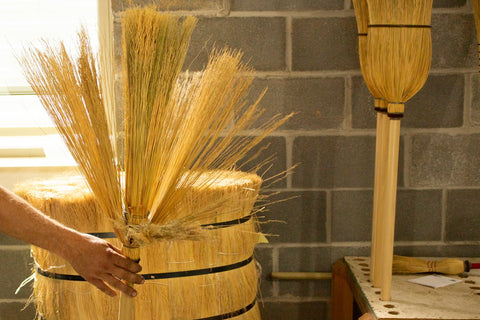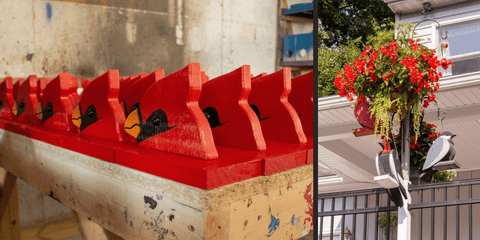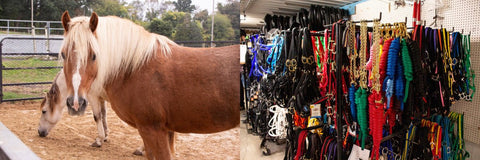
For this blog article, we travel south towards Quarryville, and visit the home of Aaron Glick. Aaron lives in a rural area with his wife Katie and five children. They own a small yet efficient broom making operation. They have sold brooms to Good’s Store for several years.
Aaron grew up making brooms. His father made brooms on his own equipment and sold them directly to customers. Some of Aaron's favorite memories were the times they would take a wagon load of sixty to seventy brooms to their produce stand along Route 340, on the western side of Bird in Hand. Sometimes they would sell out. This gave him business training for when he was older. It also showed him there was a demand for brooms.
In 2015 his dad found a set of broom making equipment in excellent condition, which Aaron bought. “I was very fortunate when I bought this equipment. You don’t often find some equipment that’s in this condition when we found it.”
Aaron’s business is actually only a side operation. He is a full time welder/fabricator, and in the evenings makes brooms, a task that can be very relaxing after a long day of work. He works with his family, and all five of his children help in the process at times. The children don’t work on the machinery, but they can help in small ways. A highlight for his children is when an order of brooms is done, and they all take a trip to Good's Store.
How has working with family, while growing up and now, shaped your perspective?
“Well, I always thought it made me a better person growing up. It gave us responsibilities at home and I guess that’s sort of what appealed to me with our children.”
What have been some of the highlights, milestones, or favorite memories from broom making?
“It always feels like it’s an accomplishment when we finish an order up and we take it out. The last time you guys ordered, there were well over two hundred brooms, and that was a milestone for us.”
What are some of the more challenging things about broom making?
“I’d say a big challenge, like with the last order, was doing it on the side. You know, there were times I thought to myself, ‘You know, I really think I could do this full time if I really wanted to.’ So basically I think finding time to really do it.
“The biggest challenge is that all of this stuff is grown in Mexico, and quality of material can be a challenge, you know that’s something we don’t have a lot of control of. I can’t see it till it’s here. So that might be one of the challenges.
“I mean, honestly, keeping everything going nice. It’s not a big challenge, but staying consistent with it being on the sideline, that can be a challenge.”
What are some favorite stories that stand out, or any other stories you want to share from broom making?
“We went to the East Earl Good’s Store on Vendor Days and we had quite the audience there, and that seemed like it was the turning point for Good’s and for us. There were people there just all day long, and that was just really interesting for me. We see it in the general public where people fifty plus express interest, but that’s not what we saw at East Earl. Everyone was watching.”
What’s a long term goal or vision you have?
“I would say the long term vision that we have is, as I had mentioned before, I’m a welder fabricator now, and a part owner of that company, and me and Katie talked about this; it would be a great retirement job.
“You have to enjoy it. You know, I’m the kind of person that enjoys doing something. And you would have to be that kind of person that actually enjoyed it in retirement. It would definitely be sustainable if I put everything into it.”
Do you have any advice for the customers who use your brooms?
“The material that is grown is straw. It’s actually a corn and this is the tassels of the corn. Now all this is grown in Mexico or South America. And what I see as harmful to the broom is if it’s standing outside and it’s wet. If someone has it standing on the bristles; that will definitely shorten the life of the broom.”
What has making brooms taught you?
“Commitment to fill an order when it’s there. That is definitely something that I’ve known for a long time, and even for the children. It gives them an end goal. Like with this last order of 200, we wondered how long it would take us, we tried to split it out and have so much done by this time, etc. I’d say the biggest achievement was having the children involved on end goals like that.”
Aaron also demonstrated how to make a broom. He started out with bundles of straw, and finished with a quality broom. The entire process took less than 25 minutes, and would have taken even less time if he would not have stopped to helpfully explain parts of the process.

Broom Corn on a scales.

Close up of fibers.

The broom corn soaks in hot water for several minutes to make it flexible.

The handle is attached to a foot operated spindle.

As Aaron adds fibers, wire wraps around them to fix them in place.

Assembled broom before sewing and cutting.

Needle and thimble.

Sewing the broom.

Cutting the broom to size. Photo by Sheldon Beiler

Finished Product.
All photos taken by Susan Burkholder unless otherwise marked.

Photo by Sheldon Beiler




Comments (5)
In answer to Carolyn from Arcola. Broomcorn is a sorghum, not a corn. That said, of course it could be grown in your area. It once was, but it now comes from Mexico and very little grown in US as it’s very labor intensive and there is no one who wants to work that hard in this country, so it’s cheaper for it to be raised in Mexico and we buy their broomcorn rather raise our own. Lots used to be raised in OK it was the state for broom corn, but I don’t think anything is raised there but a couple private patches today.
Fascinated, just like Elaine’s comment. This style is prefered in Jamaica cause it lasts longer than locally produced items for $1 with its unsewn head and actual tree branch handle, which is a hoot to use. :)
Thank you for this article. We love these brooms. I have purchased several. We use them
all the time on our farm here in Schaefferstown.
I live in Central IL. The small town of Arcola, IL also has a broom festival in the late summer. I have purchased several brooms from them. Was told that the broom material is hard to get and comes from Mexico. Is there any reason that it can’t be grown in IL since there is so much corn grown?
Would also like to know if you ever make colored brooms or one with short handles which I am fortunate to own.
Thanks for the article.
As a wool and fiber spinner for 30+ years I have enjoyed educating people on how yarn was, and is still made on a spinning wheel. The satisfaction of seeing someone watching in awe of such a simple and age old method of making what people just take for granted is very rewarding. I’m always fascinated watching anything made by hand. I hope to be able to see a broom made one day.